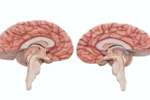For those who have experienced it, sciatic nerve pain is hard to forget. The lower back pain associated with sciatica can be debilitating, and radiating pain from sciatica can affect a large portion of the body. Though the pain in your lower back and legs may be obvious, many different potential causes can make it hard to diagnose the source of sciatic nerve pain without consulting a doctor or physical therapist.
What is the Sciatic Nerve?
The sciatic nerve runs from the lumbar spine through the pelvis and branches down both legs. Sciatic nerve pain, or sciatica, arises from pressure placed on the sciatic nerve. The length of the nerve can mean many varieties of low back and leg pain share common causes, as pressure anywhere along the nerve can result in pain and numbness in many areas of the lower back and legs.
Thankfully, finding pain relief for individuals suffering from sciatica can often be easier than you think. Unlike other forms of nerve pain that arises from damage to the nerves themselves, sciatica is typically relieved when the pressure on the sciatic nerve is alleviated. One example is pressure originating in the piriformis muscle, a muscle running through the buttocks from the spine to the back of the leg at the top of the femur. When the piriformis is irritated, it can become inflamed and a condition called piriformis syndrome can result.
Relief from sciatic nerve pain such as that caused by piriformis syndrome is often achieved by physical therapy. Treatment usually begins with stretching and strengthening of the muscles around the hips and pelvis. By working out tightness that can form in the buttocks and back of the leg, many sciatica sufferers can find relief without drugs or other medical intervention.
Use Caution When Performing Sciatica Stretches
Not all sciatic nerve pain can be helped by stretching alone. If you or someone you know has been doing stretches for sciatica pain relief but the pain persists, it is time to talk to your doctor. Serious conditions such as a bulging or herniated disc in the spine, compression fractures, spinal stenosis, osteoporosis or even spinal tumors can place pressure on the sciatic nerve. These are all serious conditions that demand you seek medical advice.
Three of the sciatica stretches in this article are static, and are fairly safe for many people. These stretches, some of which are based on yoga poses, are great additions to basics like the standing hamstring stretch often recommended by your physical therapist.
The last three exercises described below involve twisting motions. Twisting sciatica exercises can relieve stress and help alleviate some sources of pressure on the sciatic nerve. These kinds of motions can also cause more pain and damage if the source of lower back pain is a herniated disc or other spinal injury. You should always consult your doctor before beginning any treatment for sciatic pain.
Sciatica Stretches for Pain Relief
1. Knee Hugs
Lie on your back, legs extended along the floor. Begin by taking a deep breath in. As you exhale, tighten your abdominal muscles (being careful not to use your lower back!) to bring one knee toward your chest. Wrap your hands around your calf just below the knee and hug your leg gently toward body. Hold this position for three to five breaths, while breathing deeply. On your final exhalation, release your leg and slowly return it to the starting position on the floor. Repeat with the other leg.
2. Child’s Pose
Child’s pose is among the easiest and gentlest way to ease sciatica pain. Begin kneeling on all fours, with your hands directly under your shoulders. Bring your toes together until they touch and open your knees wide enough for your ribs to fit between them. Slowly sit your back with your hips resting on your heels. Keep your shoulder blades on your back and shoulders wide apart. You can rest your forehead on a block to relieve stress on your neck if your forehead doesn’t touch the floor.
3. Cobbler’s Pose
Come to a seated position on the floor with the soles of the feet touching and your knees wide apart in front of you. Bring your feet as close to you as is comfortable. Begin by taking a deep breath to help lengthen the spine. As you exhale, try to lengthen the tailbone down toward the floor. Take another deep breath, and as you let it out, slowly fold forward over your feet. Instead of rounding your back, hinge at the hips and keep your spine straight as you bend forward. Depending on your flexibility you may not be able to go very far down at first. Hold the stretch for 30 seconds to a minute.
4. Standing Twist
Stand facing a chair. Lift your right leg up and place your right foot on the seat of the chair. Stretch your spine by pulling your head toward the ceiling and your tailbone toward the floor. Take a deep breath, gently twisting up to the right as you inhale. Place your right hand on your hip and your left hand on your right thigh. Hold this position for 30 seconds and visualize your spine growing longer as you turn. Release the stretch slowly and switch legs to repeat with the opposite leg.
5. Supine Twist
Lie on the floor with your arms straight out away from your body and your knees bent with your feet flat on the floor. Tighten your core as you exhale, bringing both knees up directly above the hips so your calves are parallel to the floor. Take a deep breath, then release both knees to the right as you exhale. Breathe here for 30 seconds. Don't worry if your left knee won't go all the way down when you first start practicing this stretch. Keeping your core tight, exhale as you bring your knees back up to the center. Take a deep breath and repeat the stretch to the left side, slowly lowering until the left leg touches the floor.
6. Seated Twist
Seated twists can help relieve the pressure causing some kinds of sciatic nerve pain coming from tightness in the lower back and hips. For this stretch, begin by sitting cross-legged with your back straight and tailbone stretching down into the floor. Lift your low belly up and in toward your heart as you stretch the top of your head higher away from the floor. As you inhale, raise your arms over your head, then on an exhale, imagine pinning your navel to your spine and twist to the right, placing your right hand behind you and the left hand on the right thigh. Keep your hips level and your buttocks grounded to the floor keep the base of your spine stable. Breathe deeply as you hold the stretch for five breaths. Release the stretch by lifting your arms above your head and returning to center. As you exhale, continue turning to repeat the twist to the other side.
Talk to Your Doctor About Sciatica Stretches
It is important to consult a physician before beginning any program of stretching, exercise, or physical therapy. Stretching or exercising, especially exercises involving twisting motions can cause further spinal stress in some circumstances. In addition to talking to your doctor, it is important to listen to your own body. Stretching should provide pain relief, not create more discomfort. If you experience sharp, stabbing pain during a stretch, stop that exercise immediately and avoid it in the future. It can be intimidating to begin dealing with back pain. Fear of making your pain worse shouldn’t stop you from finding relief.
Contact NewSouth NeuroSpine today to set up an appointment. No matter what the cause of your sciatica, our specialists can help get you started down the road to recovery and relief from back pain.






